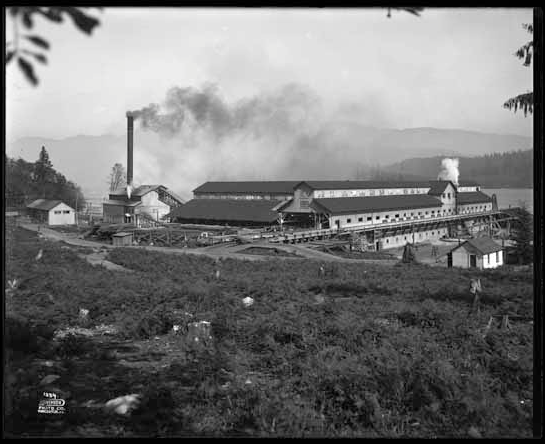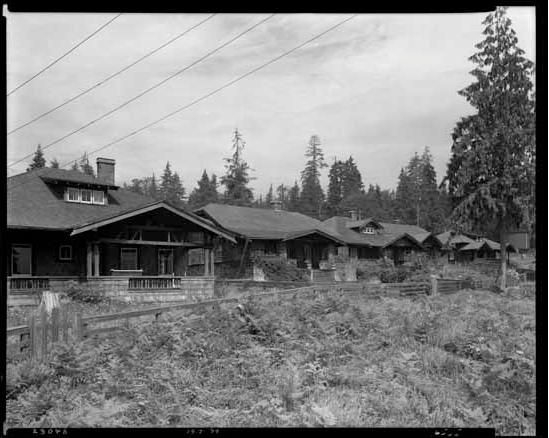If you’re looking for something a little different, skip Quarry Rock, Honey’s Donuts and the ice-cream shops of Panorama Drive and head to Cates Park.
There’s a ton of history spread over the six kilometres of waterfront park.

Robert Dollar:
In 1916 a San Francisco-based lumber baron named Robert Dollar bought 100 acres and built a huge mill at the bottom of what’s now Dollar Road. There were no roads leading into Dollarton, no bridge spanning the Second Narrows, and no regular ferry service. Dollar built a wharf for his ships and a town for his employees with a post office, gardens, community hall, church and school. He rented houses to his employees for $15 a month.
The Dollar Mill operated until 1942.

The Mill:
See that strange cement structure in Little Cates Park? My kids thought it was a castle and used to play in it when they were little. Although it makes a great fort, it’s actually the remains of a waste burner and the only thing left to tell the story of the lumber mills that operated around Dollarton in the early part of the 20th century.

The mill changed hands a few times and closed permanently in 1929 at the onset of the Depression.
Squatter shacks started to pop up around Roche Point in the 1930s, and by the 1950s there were close to a hundred along the waterfront, many built on pilings and erected from wood and other materials scavenged from the beach. There was no running water, no electricity and no heat. The most famous of the squatters was Malcolm Lowry, author of Under the Volcano among others. His shack was one of the last holdouts–all traces of the shacks were destroyed by 1957.
If you look out over Burrard Inlet you can still see the same view that Lowry looked out on more than 50 years ago—the Burnaby oil refinery that he hated—has been there since 1932.

© All rights reserved. Unless otherwise indicated, all blog content copyright Eve Lazarus.



19 comments on “A Short History of Cates Park”
I drive truck for a living . For about 20 years I owned the truck and any time I delivered a load to the North Shore I would try to escape work and go to Cates Park. Ill send you a photo of my hound sitting on a genuine Cates Park tree stump. What a great place to spend (waste) time
Lowry would have hated “Lowry Lane” and its multimillion-dollar (pun intended) houses. He didn’t even like the development of Dollarton/Deep Cove in the 1940s.
Would have been nice if the plaque that’s on the trail was attached to his old shack
Re: “Plaque on Malcolm Laurie Trail should of been posted on his shack “
There is a smaller plaque on a very large rock on the beach at the bottom of the bank in the exact location of his shack. It’s very near East Cates on the trail that spills out into the playground area and there are wooden stairs to get down to it. No signage on the trail to reference the location — you must search for it. The bronze plaque just simply states: “Malcolm Laurie Shack”.
Thanks Richard, I’ll look for that next time I’m there.
Hey Crawford. This is all great information for me. I first lived in Deep Cove upon moving to Canada and know little about its history. Val Jacober
Get hold of Lowry’s short-story collection Hear Us Oh Lord From Heaven Thy Dwelling Place. Stories like Gin and Goldenrod describe “Dark Roslyn” (as he called the Cove) very vividly.
Actually…
“If one has to be threatened with eviction, to be threatened for the sake of a park is perhaps best.”
-Lowry’s resigned endorsement of a future Cates Park.
So you are talking about Little Cates Park then? I think that is where the cement structure is? Also you said that all traces of the shacks were destroyed in 1957 but wasn’t the last one (the turquoise one) just removed a few years ago? I think that was the one where Lowry and his wife lived and it is currently being restored, I think? Not sure where they intend to put it though.
Yes, indeed, the cement structure is in Little Cates Park. The Squatters shacks–including Malcolm Lowry’s were spread along the trail from Little Cates Park to Cates Park. There’s a plaque at the entrance. The Blue shack that you mention was originally built as a float home in Coal Harbour in the ’30s and I’m not sure when it was moved to the North Shore. It sat the other side of Cates Park near the McKenzie Barge shipyard, and where all the new condos are going up/have gone up. Carole Itter and Al Neil lived there on and off since the 60s.
For years there was a wonderful small plaque on a big rock down on the shore, which gave the exact location of Lowry’s “beloved shack.” Unfortunately, the sign went awol. Shortly after its disappearance, another plaque appeared above on a tree stump along a nearby trail, not in the shack’s exact spot, but close. Don’t know if it’s still there. Al Neil and Carol Itter’s little blue cabin is being restored by the Grunt Gallery: http://grunt.ca/the-blue-cabin/
Thanks Shelley I didn’t know about the first plaque. The new one is still there, or was last time I looked. Looking forward to seeing the restored blue cabin!
I have been visiting the park since 1955. Remnants of the shacks remained until the early 60’s. Every major storm would reduced the numbers. One of the last to go was the superstructure of a large tug on pilings. I grew up in that park, sleeping at our house on Beachview but spending every unstructured minute (of which there were lots for kids back then) in the park. There was an ancient (in my eyes) native man who lived in a large hollowed cedar stump above the drinking steps, who would regale us with stories of times long lost. He was just not there one day when I was about 4. The trails were just forest mulch and forgiving to knees when falling from racing bikes. Little Cates was just the base of the beehive burner ( the Alamo to us) surrounded by blackberry and maple. Big Cates was a little grassy area no more than a couple of hundred metres square leading up to the Roche Point lighthouse. To honour this nurturing forest, a few of us old Covers, resurrected the Village Faire of 1970 with a Village Faire II in 2012. Whenever I am in the Lower Mainland, I try to find whatever time I can to visit Cates – it’s a homecoming.
Thanks so much for stopping by with all these amazing memories! It’s also the first time I’ve heard of the Roche Point Lighthouse.
my mother’s family, the Craigs, were amonst those that lived in the squatters cabins along the beach.one of my great aunts, my great grandfather, my great grandmother,[ they were separated, so, separate dwellings as well], and my grandfather, all had houses next to each other. nestled in the middle was the boat house, and wharf. I have many pictures of my mother, and her sisters, various cousins, etc., as kids, swimming , boating ,fishing, and playing on the wharf, and the raised wooden walkways along the waterfront. my grandfather, jimi, and his brother, kept their fishboat there. the family would row across from Burnaby, in small dingys that my greatgrandfather built.
both my great grandfather, and grandfather, were quite good friends with Malcolm lowry, who, a notorious drunk, would often tip a few together.
when I can, I love to go to cates and reminisce.i actually lived in a squatters shack myself for a short time in the ’70;s. at the other end of cates, a couple of hundred feet from al neil
Thanks so much for stopping by with this – would love to time travel back and see all this!
I also grew up playing in Cates as we lived a block away on Roslyn Blvd. I remember when the district cleared away some of the beautiful bush at the far end nearest my home to plant grass and install playground equipment. The big swings are still there. My friends and I used to refer to the two grassy ends of the park in our conversations, as Big Cates and Little Cates and these names have been passed down and still being used today or so I have noticed. What we called The Alamo, became The Castle for my children. My friends and I spent many happy days watching the seasons and exploring every inch of the park. We were so fortunate to spend our summer days sunbathing on it’s beaches, swimming in the icy waters and running barefoot over the rocks and barnicles. I still love to spend time there…so many vivid memories. In reference to an earlier comment, Malcolm Lowry’s plaque is still cemented onto a big boulder, there on the beach where stood his beloved shack…it has fallen over, the plaque now lays underneath and still there the last time I had a look.
Thanks for dropping by Janet and for the information about the plaque. Will go on a hunt for it next time I’m walking the dog over there.
[…] A Short History of Cates Park […]